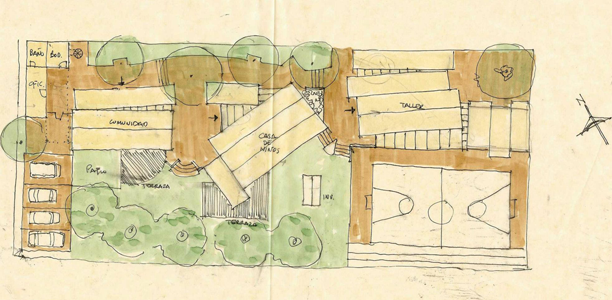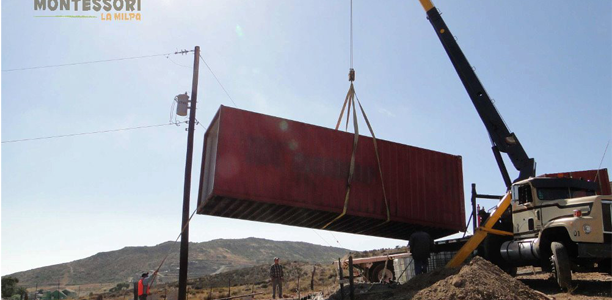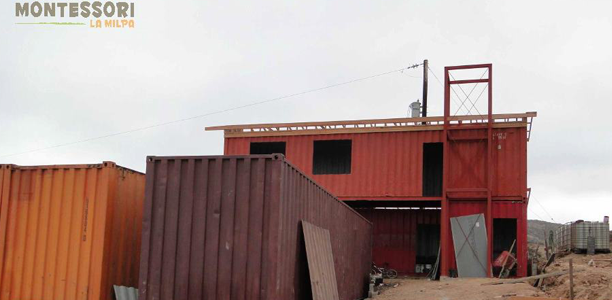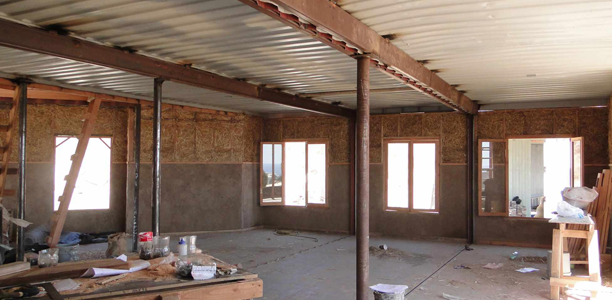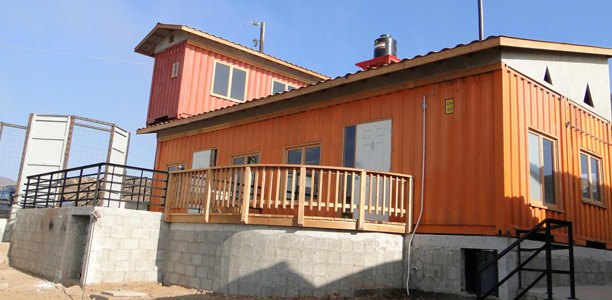Following the success of our first interview last week with Brenda, we have decided to continue the interview series as many of you emailed us letting us know how helpful it has been.
It brings me great pleasure to bring onto this weeks show Fernando Saldain from Montessori La Milpa.
Fernando is the Founder of Montessori La Milpa, which is a primary school based in Ensenada, Mexico.
He has an incredible story as their school is primarily built out of shipping containers- so let’s get straight into this interview!
It brings me great pleasure to bring onto this weeks show Fernando Saldain from Montessori La Milpa.
Fernando is the Founder of Montessori La Milpa, which is a primary school based in Ensenada, Mexico.
He has an incredible story as their school is primarily built out of shipping containers- so let’s get straight into this interview!
About Montessori La Milpa
Tom: Please can you tell our readers a bit about your school?
Fernando: Montessori La Milpa started in September of 2010 and we currently teach children between the ages of 1-6 years old. In the fall we will be starting our elementary classroom and we are expecting to have about 10-15 children in the first school year.
Aside from the Montessori program, we have a very strong environmental focus. We harvest rainwater in a cistern that can hold 133,000 liters. We also have composting toilets and a composting program where parents bring their organic scraps from home. In addition to all of this we have just started a recycling collection center, in the same manner families can bring their recyclables and the proceeds from this is donated to a local dog/cat shelter that rescues stray animals.
Tom: How did you get the idea of building your school with shipping containers?
Fernando: We wanted the architecture of the school to match it’s philosophy, diversity and keep an environmental focus. We are actually located a few miles from one of the two marine port terminals and there are several shipping container storage yards located in very close vicinity. I had seen an article online regarding shipping container homes, several years ago, and although there are very few constructions with shipping containers in town, I figured it was worth exploring. So we presented the idea to our architect and he is the one to credit for the fabulous results.
Fernando: Montessori La Milpa started in September of 2010 and we currently teach children between the ages of 1-6 years old. In the fall we will be starting our elementary classroom and we are expecting to have about 10-15 children in the first school year.
Aside from the Montessori program, we have a very strong environmental focus. We harvest rainwater in a cistern that can hold 133,000 liters. We also have composting toilets and a composting program where parents bring their organic scraps from home. In addition to all of this we have just started a recycling collection center, in the same manner families can bring their recyclables and the proceeds from this is donated to a local dog/cat shelter that rescues stray animals.
Tom: How did you get the idea of building your school with shipping containers?
Fernando: We wanted the architecture of the school to match it’s philosophy, diversity and keep an environmental focus. We are actually located a few miles from one of the two marine port terminals and there are several shipping container storage yards located in very close vicinity. I had seen an article online regarding shipping container homes, several years ago, and although there are very few constructions with shipping containers in town, I figured it was worth exploring. So we presented the idea to our architect and he is the one to credit for the fabulous results.
Tom: Why did you decide to build your school out of shipping containers?
Fernando: We looked at other options like straw bales, adobe blocks, bricks, cinder blocks, etc. They obviously all had their pros and cons. We decided to go with shipping containers mainly for three reasons:
Fernando: The construction started early June of 2010, classes started in September of that same year in two of the three classrooms. The third was completed by October, but the construction schedule was reduced due to classes in the mornings.
Tom: Roughly how much did the school cost to build?
Fernando: We looked at other options like straw bales, adobe blocks, bricks, cinder blocks, etc. They obviously all had their pros and cons. We decided to go with shipping containers mainly for three reasons:
- The cost was about the same as a traditional cinder block constructions, but the upside was the long term durability (reduced maintenance),
- The fact that the containers were being re-purposed rather than recycled
- Finally, the also the novel aspect of building with shipping containers, as there are no other constructions of this magnitude in our area.
Fernando: The construction started early June of 2010, classes started in September of that same year in two of the three classrooms. The third was completed by October, but the construction schedule was reduced due to classes in the mornings.
Tom: Roughly how much did the school cost to build?
- Land $50,000USD
- Containers $50,000USD
- Foundations $40,000USD
- Cistern $25,000USD
- Woodworking $50,000USD
- Fencing $20,000USD
- Electric/Plumbing $15,000USD
- Steelwork $12,000USD
- Concrete (exterior floors) $12,000USD
- Misc $10,000USD
Tom: Can you talk about the process of building the school- what were some of the highlights of the process? Fernando: I can still remember watching that first red container being crane lifted and placed into it’s location. It was a 30′ segment from a 40′ container that had been prepared at a local lot prior to it’s arrival. Even though our architect did a great job on the design and supervising the actual construction, there is always that sense of uncertainty until it all starts coming together- especially having designed this from specifications and not actually measuring the containers.
But I must say everything came together very nicely and there were minimal surprises that had to be adjusted in real time. There were several crews working at the same time, foundations were being poured while doors, windows were being opened and insulation was being fitted. We had a delay in getting the building permits, to some extent we figured it might be delayed due to the shipping containers, but it was actually delayed for other non related aspects!
Tom: How did you insulated the containers?
Fernando: The interior walls have loose straw that was packed from floor to ceiling, about 3.5” thick, held back by chicken wire. Then a layer of adobe plaster was applied to the full height.
In the exterior, all the classrooms have exterior roofs that where made from the corrugated sheet metal that was removed from interior walls. There is an air gap that is formed between this exterior roof and the inner ceiling in addition to ventilation openings which helps circulate air.
The climate in our location is relatively mild- We are located less than 1 mile from the coast line so we have a very nice cool breeze during the day, the distribution of classrooms and windows was done to take advantage of this breeze to keep classrooms cool during summer.
The windows also provide natural light and a heat source during winter.
But I must say everything came together very nicely and there were minimal surprises that had to be adjusted in real time. There were several crews working at the same time, foundations were being poured while doors, windows were being opened and insulation was being fitted. We had a delay in getting the building permits, to some extent we figured it might be delayed due to the shipping containers, but it was actually delayed for other non related aspects!
Tom: How did you insulated the containers?
Fernando: The interior walls have loose straw that was packed from floor to ceiling, about 3.5” thick, held back by chicken wire. Then a layer of adobe plaster was applied to the full height.
In the exterior, all the classrooms have exterior roofs that where made from the corrugated sheet metal that was removed from interior walls. There is an air gap that is formed between this exterior roof and the inner ceiling in addition to ventilation openings which helps circulate air.
The climate in our location is relatively mild- We are located less than 1 mile from the coast line so we have a very nice cool breeze during the day, the distribution of classrooms and windows was done to take advantage of this breeze to keep classrooms cool during summer.
The windows also provide natural light and a heat source during winter.
Tom: What’s the one thing you wish you’d known before you built your shipping container school?
Fernando: That there are containers that don’t have a tubular beam that goes across the top of the length (long sides), but rather have an ‘L’ shaped beam that is much weaker when the inner wall is removed completely. We had to add ‘C’ shaped beams to reinforce that length.
Tom: In your experience what are the advantages of building with shipping containers?
Fernando: I believe the long term durability and relatively low maintenance is far more advantageous when compared to cinder block constructions, which is the most common type of construction in our area. Also, if the overall condition of the container is good, there is no real need for exterior paint. Interior floors can be refinished and there is no need for additional flooring.
Tom: Would you recommend building with shipping containers?
Fernando: Of course, anything from a small off-grid home to a large scale construction like our school, the possibilities are nearly endless!
Fernando: That there are containers that don’t have a tubular beam that goes across the top of the length (long sides), but rather have an ‘L’ shaped beam that is much weaker when the inner wall is removed completely. We had to add ‘C’ shaped beams to reinforce that length.
Tom: In your experience what are the advantages of building with shipping containers?
Fernando: I believe the long term durability and relatively low maintenance is far more advantageous when compared to cinder block constructions, which is the most common type of construction in our area. Also, if the overall condition of the container is good, there is no real need for exterior paint. Interior floors can be refinished and there is no need for additional flooring.
Tom: Would you recommend building with shipping containers?
Fernando: Of course, anything from a small off-grid home to a large scale construction like our school, the possibilities are nearly endless!
Thank you for joining us for this interview Fernando! And thank you to everyone reading this. Remember if you have any questions about the construction process, or using shipping containers let us know in the comments below.
